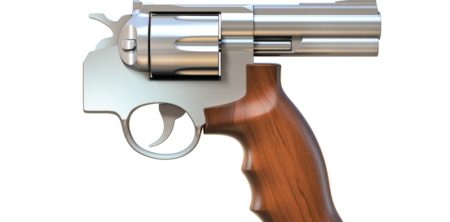Using Gun Metrics to Demonstrate How to Make a Stronger Argument and Drive Better Conclusions
As a Six Sigma Black Belt, I believe 100% in using data to make the majority of decisions. As Deming was purported to say, "In God we trust. All others must bring data." Data is something most people agree is a good practice and strive to incorporate into drawing conclusions and decisions. At the same time, have you ever noticed that there tends to be as much data supporting a cause as there is arguing against it? It can get so confusing that most people will turn their backs on the numbers and make decisions based on their gut and their own personal experiences, which makes it tremendously harder to drive toward a win-win solution.
A prime example of this is in relation to the ongoing and very heated Gun Control debates. By dissecting some data examples, I hope to provide some guidance on how each side is guilty of presenting flawed data, what qualities tend to be included in more accurate data, and the steps to avoid making similar data analysis errors in business.
NOTE: The examples below are in no way intended to argue for or against gun control. There are lots more relevant data points that need to be considered. This discussion is only to point out analytics that are more accurate and likely to stand up in an argument regardless of which side of the coin you are on.
Step 1: Convert Discrete Data into Continuous Metrics
One key point that most (in my opinion) good statistics (and six sigma) classes mention is the power of continuous data over discrete. As the website www.MathIsFun.com explains, "Discrete is counted. Continuous is measured." Six sigma itself is explained in terms of continuous data: 3.4 defects per million opportunities. Yet, I cannot tell you how often in my career I have seen analytics in business using discrete data to draw conclusions-- from Pareto charts of train derailments by month (regardless of the miles traveled), to volume of IT trouble tickets by department (regardless of size), to trouble calls by device (regardless of customers on that device). A lot of time and effort is spent developing charts and analysis only to be wasted by the fact that they were taken out of context of how many opportunities existed for those events to occur. In the case of guns, here is an example where the data falls short of drawing any good conclusions: 
Interesting, but little decision making can be made from it. Both sides of the argument tend to use this number as an example to support their cause. Pro-gun advocates point out how important guns are to the American way of life while gun control advocates use this number to point out how armed the population is. Either way, it's nice to know but contains little value in an argument for or against.
Now consider how this number is re-evaluated as a continuous metric: 
This is a little more telling... 270 million guns equates to roughly 90 guns for every 100 people. It's just an average, so it still may be difficult to draw many conclusions except that now, it can be used in two ways: 1) Further detailed analysis, and 2) For comparison sake.
Step 2: Consider the Value of Precision and Measurement Validation
An average is the simplest form of continuous data, but what do we learn when we take it down to a more precise measurement such as the chart below:
Now we find that rather than thinking that 90% of the U.S. population owns a gun, less than half of the population actually own a gun. This also means that they tend to own multiple guns. Good to know.
NOTE: The thing I like best about this graphic is that it brings in data from two different independent sources. It's a nice form of measurement validation. While the numbers are not the same, they are close and both show that gun ownership per household is less than 50%.
Step 3: Compare the Data to Other Control Groups
This is a very important step as it helps to draw some relevance to the data. Case in point...
 While almost 90 guns per 100 people may sound like a lot to some and not enough to others, it gives no reference of relativity. This map is a bit more informative as it compares the U.S. to other countries. It's clear that we have many more guns per person than any other country in the world. Now let's check the impact on the thing we want to change ==> gun violence.
While almost 90 guns per 100 people may sound like a lot to some and not enough to others, it gives no reference of relativity. This map is a bit more informative as it compares the U.S. to other countries. It's clear that we have many more guns per person than any other country in the world. Now let's check the impact on the thing we want to change ==> gun violence.
Step 4: Correlate the Data
Many people will use correlations that best suit their needs and this is where the analytics become like shooting targets as the holes become obvious (all puns intended). Having a skeptical eye will help you ensure you are not being conned by an intentionally skewed perspective. Here is an example. Look at the two charts below:

This first chart compares the number of guns per person to the gun related death rate in multiple countries in the world. It makes the United States look pretty good. The uneducated eye draws the simple conclusion that the United States has a fairly low rate of firearm deaths because it has a highly armed population. Of course, there are other countries that have low gun related death rates AND much lower gun rate per person. If you actually know how to properly evaluate correlation charts like this, you will know that this chart actually demonstrates that there appears to be no DIRECT correlation to the gun related death rate and the percent of armed people. A direct correlation should have resulted in a trend line associated with the X and Y axis.
 Interestingly enough, this graph does show a trend line (stronger correlation) between gun related death rate and the percent of armed people when the comparison groups are limited to countries who are actually similar to the U.S. in things like life expectancy, education and income. Every time there is an argument for or against something, we need to be diligent in asking:
Interestingly enough, this graph does show a trend line (stronger correlation) between gun related death rate and the percent of armed people when the comparison groups are limited to countries who are actually similar to the U.S. in things like life expectancy, education and income. Every time there is an argument for or against something, we need to be diligent in asking:
"Is this really an appropriate group(s) to compare against?"
NOTE: A few items that need to be considered....
- Measurement validation is important. Perhaps not every country is properly reporting gun ownership or gun related death rates.
- Consider all descriptors and be sure it is a representative sample. For example, I found a statistic used repeatedly that "With just 1 exception, every public mass shooting in the USA since 1950 has taken place where citizens are banned from carrying guns." That is not to say that ALL mass shootings occurred where citizens were banned from carrying guns - only that the public mass shootings were. To determine if mass shootings tend to occur where the citizens are not armed, we should be looking at ALL mass shootings - not just those in locations that tend to prohibit guns in general.
- The most reliable analysis is designed and developed by independent parties who use these four steps. On both sides of the gun control debate, I have seen data presented by groups with a bias, which tends to influence their presentation of the information. The data presented by as non-biased parties as possible tend to be the most accurate.
Again, this is a fraction of the data points about guns and gun violence that exists so it is not meant to argue one point over another. That said, I for one, will be most swayed by arguments that present stronger data no matter what the topic. And I encourage you to use a skeptical mind when looking at data you present or use to draw conclusions so you are using the most accurate information.
- Is the data presented as discrete or continuous?
- Has the data been validated by another source?
- Is there more precision needed to make this information more valuable?
- Is the information presented relative to anything? Are the comparisons proper comparisons?
- Has a proper correlation been established? Perhaps using actual statistical tools (not just charts on top of each other) or subjective data?
It is my sincere wish that with every important decision or controversial subject, we are using accurate data to draw good conclusions so we can in turn make good win-win solutions.
Sources in order of graphic:
http://americangunfacts.com/#sources
http://visual.ly/gun-violence-america
http://www.people-press.org/2013/03/12/section-3-gun-ownership-trends-and-demographics/#profile-guns
https://www.washingtonpost.com/news/wonk/wp/2015/12/03/one-map-shows-why-americas-gun-violence-is-so-much-worse-than-anywhere-else/










Williamvads